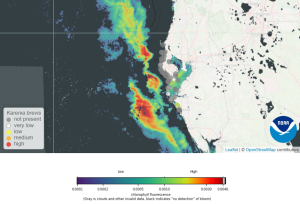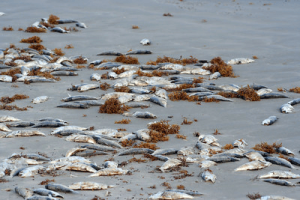Following major rainfall events, the influx of nutrients into the coastal system from stormwater runoff can create favorable conditions for harmful algae blooms! With the west coast of Florida experiencing two major hurricanes back to back, both of which caused extensive rainfall and storm surge flooding, our risk of red tide in the area is heightened. Large algae blooms of Karenia brevis, the algae that produce red tide, have been detected following several other hurricanes in the past.
Current red tide

According to FWC, as of 18 October 2024, a large algae bloom can currently be observed off the coast of the western Florida coastline, near Pasco, Pinellas, and Sarasota counties. High levels of Karenia brevis were measured offshore of Pinellas County, however, Florida’s western inshore coastlines are currently not showing the presence of red tide. No fish kills have been reported as of yet.
Models show currents moving the offshore blooms towards the coastal regions over the next week, which could allow people and animals in coastal communities to feel the effects of red tide. Due to the high levels of rainfall and storm surge runoff in the coastal waters, caused by hurricanes Helene and Milton, nutrient concentrations in coastal waters are high. These high nutrient levels would favor red tide bloom development if the algae makes its way close enough to the coast.
Currently, red tide, along the coast is not likely to cause respiratory irritation as levels remain low or not detected (18 October 2024, FWC).
To monitor the current levels of Karenia brevis near you use the FWC Red Tide current stats page.
The daily map of the measured sampling can be found here: MAP
If you see a fish kill and suspect it is be related to red tide you can report it here: Fish kill hotline
Harmful algae blooms
Algae blooms occur when colonies of algae grow out of control as levels of nutrients that enter the coastal waters exceed certain thresholds. These algae blooms can dominate the water column, blocking out sunlight, reducing oxygen levels, and releasing toxins, causing harm to plants, animals, and humans.
Red Tide
Red tide is a type of harmful algae bloom (HAB) caused by a type of marine phytoplankton called dinoflagellates. The specific microalgae that cause red tide, Karenia brevis, can bloom in such large amounts that the waters turn red, green, or brown. Karenia brevis algae blooms can also produce toxins that can cause illness and in some cases lead to death.
Red tide is not only harmful to the health of marine and coastal organisms but can also have serious impacts on the local economy, as tourism dwindles and shellfish fisheries are shut down.
Dead zones

The algae responsible for red tide are far more harmful than non-toxic algal blooms because they both reduce oxygen levels in the water and release toxic substances, leading to issues for marine life and humans. Although the algae flourish during a bloom, they eventually die off in large numbers. This decay process further depletes oxygen in the water, potentially resulting in “dead zones” where oxygen is completely absent. In these conditions, sea life will either suffocate or leave the area, unable to survive in the low-oxygen environment.
Toxins
The secondary, but more sinister threat red tide brings is brevetoxins, which impact the central nervous system in animals. These toxins produced by the algae can cause severe sickness in people, animals, and shellfish. The toxins can be hazardous if ingested, either from contaminated water or by consuming shellfish that have been exposed to toxic waters. Neurotoxic Shellfish Poisoning is common, as the shellfish directly filter the algae and accumulate high levels of toxins. Therefore, you should avoid eating shellfish during periods when toxin levels in the water are elevated.
Wave action can break apart the Karenia brevis algae, releasing brevetoxins into the air. Once airborne, these toxins can lead to significant respiratory irritation, making it difficult to breathe. For individuals with asthma or other respiratory issues, this can result in serious, and sometimes fatal, health problems. Those near red tide events may also experience shortness of breath, coughing, skin irritation, and burning eyes. Pets can suffer similar effects.
Overall, the toxins and impacts of red tide can pose a threat to humans, fish, birds, and other marine animals, such as manatees and turtles.
Causes
Red tide is a natural event with annual blooms occurring almost annually in the Gulf, but specific environmental conditions can lead to more frequent and severe blooms.
These blooms usually start in offshore waters, where algae growth gradually increases. As the bloom grows the wind and currents can push the bloom inshore towards coastal areas. If nutrient levels in these inshore waters are high, the bloom can “explode,” growing rapidly and exemplifying local impacts. It is along the coastlines where the largest effects, such as fish kills and respiratory illness are observed.
Coastal and marine habitats need specific levels of nutrients, like nitrogen and phosphorus, to flourish. However, excessive nutrient concentrations can harm these ecosystems. Stormwater runoff containing sewage, fertilizers, and other pollutants can lead to elevated nutrient levels. These high concentrations effectively “nourish” algal blooms, contributing to severe red tide events.
More information can be found below:
Predicted Intensification forecast: Bloom Forcast
Algae bloom satellite map: Map
Learn more about local red tide here: Redtide
For more detailed information, contact your local University of Florida Extension Office.
Have a question?
Follow us!
An Equal Opportunity Institution.
 2
2
